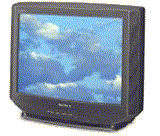|
|
|
 |
|
|
The
Media in the United States > Television |
|
After
World War II, American homes were invaded by a powerful new force --
television. The idea of seeing "live" shows in the living room was immediately
attractive. The effects of this powerful medium are still being measured.
Television has developed since World War II into the most popular medium
in the United States, one that has had great influence on American way
of life. Virtually every American household -- 98% in 1999 -- has at
least one TV set. Seven in ten Americans in 1991 reported getting most
of their news from TV. Three large privately-owned networks -- NBC,
CBS and ABC -- claimed 90 percent of the TV market from the 1950s through
the 1970s with free broadcasts. The new technology offered cable programmers a cost-effective method of national and international distribution. In December 1975, Home Box Office, an all-movie channel owned by Time, Inc., became the first programmer to distribute its signal via satellite. The next service to use the satellite was a local television station in Atlanta owned by Ted Turner. It became known as the first "superstation," bouncing its signal off a satellite to reach a nationwide audience. The same technology allowed Turner in 1980 to found the Cable News Network, CNN, the world's first 24-hour all-news channel. By early 1993, MTV, the leading American rock music TV network, had an audience of 46 million in the United States and 32 other countries. Cable television has also been successfully used to reach very defined audiences. Beginning in the late 1970s, a growing number of U.S. cable systems began "narrowcasting" or offering television programming with an entire channel tailored to a narrow section of the audience. Advancing digital technology and increasing wiring of U.S. cities with fiber-optic cable that permits massive transmission of digital signals are giving cable TV subscribers a host of new interactive services. The convergence of the computer with TV is permitting a host of new "interactive" services in which the viewer no longer watches passively, for example "Movies on demand" which allows a viewer to choose between several thousand videos is one interactive service. Another example is "shop-at-home" channels. Public
Television Self-Regulation
and Regulation |
|
| Texts
are abridged from U.S. State Department IIP
publications and other U.S. government materials. |
|
| What
kind of information materials are available?
CD: These documents are available in fulltext format on the About the USA CD-ROM. Teachers: Request a copy for classroom use. L: Selected documents are available in German as well as other languages, including Arabic, Chinese, French, Spanish, Persian and Turkish. |
DISCLAIMER
Any reference obtained from this server to a specific commercial product, process, or service does not constitute or imply an endorsement by the United States Government of the product, process, or service, or its producer or provider. The views and opinions expressed in any referenced document do not necessarily state or reflect those of the United States Government. |
 U.S. Diplomatic Mission to Germany /Public Affairs/ Information Resource Centers Updated: March 2009 |
